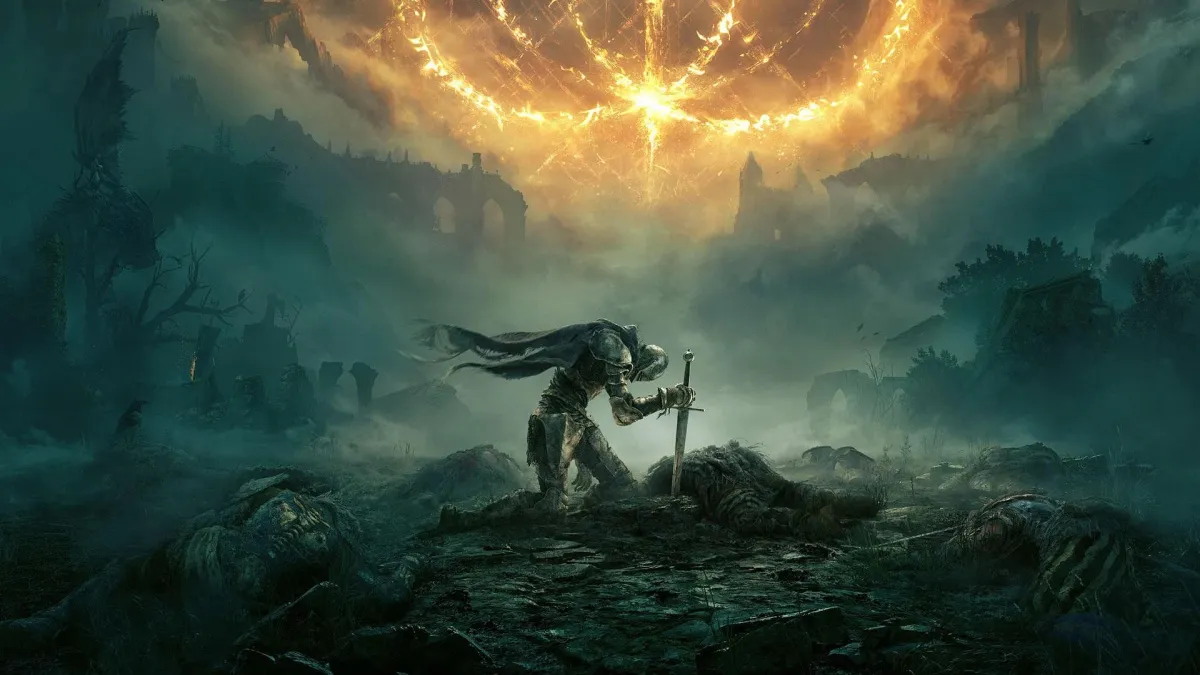Elden Ring on PC
The best part of Dark Souls –or any of the Soulsborne games, for that matter– isn’t the bosses. It’s the sense of dread and trepidation you get when you’re exploring the unknown. That fear follows the player each time they round a corner because you just don’t know if there’s an ambush waiting for you, and the pressure that comes with losing all your hard-earned Souls can be a lot to handle. All of that stress is worth it, though, as you’re eventually rewarded with an overwhelming sense of relief when you discover a shortcut or a new bonfire, and you know you’re safe… at least for the time being. That feeling is amplified 10 times over in Elden Ring. The fear of the unknown is greater than ever before, but so is the relief, and there’s nothing else quite like it.
Elden Ring is the product of a dream team collaboration between FromSoftware and fantasy author George R.R. Martin. The Souls games (and Bloodborne) have always been lauded for the way their storytelling was handled: never spoon-fed through cutscenes, only discernible through the observation of environmental clues and cryptic item descriptions.
FromSoftware and Hidetaka Miyazaki’s style of storytelling fit pretty much perfectly with the lore-writing and world-building chops of Martin, who’s best known for writing A Song of Ice and Fire. Narrative points and story beats aside, both ASoIaF and Game of Thrones succeeded in presenting an incredibly rich world with complex histories and events that are intertwined with each other. Martin knows how to create a world that feels lived in and realistic, and by having him write the overarching mythos of Elden Ring, FromSoftware is able to combine his writing with their style of “show, not tell” storytelling, and dispense that information through the environment itself.
The result? The Lands Between. A large open-world that’s clearly been devastated by some sort of calamity or catastrophic event. True to usual FromSoft fare, the game opens with a lengthy cutscene as a wizened narrator bemoans the tragedy that’s fallen upon the land. Players take control of an unnamed Tarnished, who hopes to seek out the guidance of a Maiden and take on the mantle of the Elden Lord.
The ambience is on point right from the get-go, as Elden Ring feels every bit as creepy and foreboding as FromSoft’s previous games. There’s a lot of eerie severed arm imagery in this one, and tons of circular shapes in the game’s iconography, or rings I should say.

I’ll admit I had my reservations about Elden Ring being a massive open-world game. After all, Dark Souls thrived on being set in a tightly designed, interconnected world. It didn’t need to literally be massive to feel massive; that was its biggest strength.
With Elden Ring featuring a huge overworld to explore, I was worried that the game would suffer from subpar level design as a tradeoff for a larger sandbox. While, yes, the major areas aren’t exactly connected through ingenious level design like in Dark Souls or Bloodborne, the individual areas themselves are still fantastic.
For instance, Stormveil Castle is the first major location you’ll visit in the game, and it’s a veritable deathtrap of a fortress, full of small side paths and little corners to check. The glow of the various item pickups will tempt you into walking into an ambush, and there are surprises at every turn, forcing the player to seriously consider whether they want to push on or backtrack and reset their progress with only one Sacred Flask left.
Indeed, I found that the level designs in Elden Ring could be quite punishing. The game is relentless when it comes to tricky enemy placements, often forcing you to make difficult moment-to-moment decisions. A simple example: I had the choice of either descending a ladder in Stormveil Castle, or dropping down to a ledge and going through a broken window to explore a new chamber. Both routes would take me to the ground floor, but the latter would make it impossible for me to sneak past a particularly nasty knight enemy.
But then again, dropping down to that chamber would also give me access to a new NPC who could prove very useful on my journey. It’s the little decisions like these that have always made the Souls games so engaging, and that holds true in Elden Ring as well.
I’d be remiss not to at least mention some of the new enemy types introduced here. Elden Ring features some of the most interesting enemy designs I’ve seen in a Souls game, including these marionette puppet-like humanoids with multiple arms, allowing them to wield two or more weapons at once. There’s a variant that wields two bows, and they come with the ability to spin around in a small circle, constantly shooting out arrows in all directions.
There are these round-shaped, concrete-looking beings that remind me a lot of the machines from NieR: Automata, and they roll around the place before falling flat on their faces, giving you just a couple of seconds to hit them before they get up for a counterattack. I found myself constantly surprised by the variety in enemy types, and I absolutely love that even after more than a decade of playing these games, FromSoft still finds a way to surprise me every time.
As the centerpieces of the game, the bosses also continue to be a huge highlight of the experience. Boss fights in this game are a grand event, a whole ass spectacle. The operatic orchestra kicks in whenever you traverse the mist and step into a daunting boss arena, and the music swells as you whittle their health bars down and enter the next phase. Boss phases became a thing in Bloodborne and Dark Souls III, and have since become a FromSoft staple, and yep, they’re still pretty insane here.

The story bosses, in particular, are quite challenging and you can definitely expect to beat your head against the wall for a good number of them.
Elden Ring does ease up on the difficulty factor by giving players a little more leeway when exploring the open-world. The benefit of having such a huge world to explore is that you literally don’t know what you’ll stumble upon next. The Lands Between are home to plenty of optional overworld bosses that you’ll inevitably come across by accident, before dashing away in a panic when you realize you’re woefully underprepared for such an encounter.
With so many dangers lurking around, FromSoft gives players the ability to fast travel anytime you’re out of combat. It’s a simple matter of bringing up your map, and selecting a Site of Grace (read: bonfire) to fast travel to. This feature is limited in some areas, but for the most part, the game allows you to flee pretty much whenever you want.
Recognizing that players could spend hours exploring the world without resting, the game also feels rather generous when it comes to healing. A new mechanic in Elden Ring will allow for automatic replenishment of your Sacred Flasks whenever you clear out a group of enemies in a concentrated area. You’ll only get one or two Flask charges back, but it’s a simple tweak that allows for longer expeditions, without forcing players to have to backtrack to a previous Site of Grace and reset all their progress when they could be right around the corner from the next checkpoint.
Call it a casual-friendly compromise, but I’m a big fan of this. Considering the sheer size of the overworld, I appreciated the fact that I wouldn’t be totally screwed if I was neck-deep in an unknown swamp and out of Sacred Flasks. Besides, that mechanic still wouldn’t save you if you’re careless and get 90% of your health bar depleted by random mobs, as I so often do. There’s still risk involved in trying to push ahead recklessly; it’s just been mitigated slightly here. I’m not sure this replenishment mechanic would work in a smaller scale Souls game, but in the case of Elden Ring, it definitely does.
Even when you’re armed with a map to help with navigation, it’s still incredibly easy to get lost and lose your bearings in The Lands Between. And when you’re lost, the world somehow feels even bigger and even more undecipherable. That sense of discovery and fear of the unknown that I usually get when playing a Souls game felt like it was just magnified here, and it’s awesome.

Littered all over The Lands Between are dungeons, which you can definitely stumble into by accident as well. These are usually very small-scale caves and catacombs that you can explore, and even fight a mini-boss at the end of it for some valuable loot. There are maybe one or two very simple puzzles thrown in there to trip you up, and they serve as nice contained areas that you could knock out in 15 minutes, maybe a bit more if you’re struggling with the boss.
Elden Ring’s dungeons are very reminiscent of the Chalice Dungeons in Bloodborne, except you don’t have to grind through countless levels for random materials so that you can craft a Chalice to access the next one. They’re a good source of Runes (read: Souls) and loot, and it can be helpful to attempt some of these if you’re feeling stuck in the story and need another way to progress and get stronger.
And, of course, moving on to the bread and butter of these games, the combat in Elden Ring will feel instantly familiar to FromSoft fans. Poise and super armor make a return, allowing players to become a bit more resistant to stagger by slapping on heavier armor. Sorceries and Faith-based incantations are present, along with various other familiar afflictions like Bleed, Poison, and even the much-dreaded Madness (or Frenzy) from Bloodborne, which still gives me nightmares to this day.
After being forced to play in a very specific way in the (also excellent) Sekiro: Shadows Die Twice, coming back to the familiar chunky Souls combat in Elden Ring almost felt comforting. There’s plenty of build variety to enjoy here, tons of different weapons to collect, and plenty of gear and armor pieces to check out for all the Fashion Souls fans out there.
Elden Ring also brings back the power stancing mechanic that was introduced in Dark Souls II. The mechanic itself has been simplified here, and players can dual-wield matching weapons more effectively now. Power stancing unlocks new combos and attack animations, and that just further adds to the sheer fun and variety of the combat system.
Focus Points, or FP, are also back, as are the weapon arts from Dark Souls III. There is a slight twist here; instead of attaching a specific weapon art to each weapon in the game, you can now collect items called Ashes of War, and apply them to your weapon of choice. This effectively means that players now have the freedom of choosing the type of weapon art they want for their armaments, and while I didn’t exactly dive too deep into this (my FP’s for sorcery, thank you very much), it also adds yet another layer of variety to the kinds of builds you can create in Elden Ring.
It’s as if FromSoft has taken all the best parts and little tweaks and improvements that they’ve introduced in the past Souls games, and put them together to create arguably the best iteration of Souls combat we’ve seen so far. When the game officially launches, I suspect we’ll see a lot of interesting PvP matchups, and it’ll be exciting to find out what the new meta ends up being. Watch it be power stancing ultra greatswords or something ridiculous like that.
Finally, it’s also important to note that Elden Ring has become a bit of a controversial subject in past weeks, regarding the huge recommended PC specs and the online multiplayer concerns on PC that surfaced after a new exploit was discovered in Dark Souls. I did play through the game on PC, and at the time of writing, I haven’t been able to test the online multiplayer aspect myself, be it co-op, PvP, or invasions. Bandai Namco has stated that they’ve taken the necessary precautions and security measures to ensure that the RCE exploit doesn’t occur in Elden Ring’s multiplayer sessions, but we won’t be able to actually confirm that until the game launches.
What I can say about the PC build is that I did run into some pretty gnarly stuttering issues from time to time. This seemed to happen only when I was exploring the overworld, but occasionally (like once every three hours or so) the game would straight up freeze for about three seconds before resuming, which is always a scary thing to have happen. While the recommended PC requirements are fairly lofty, this definitely wasn’t the type of issue I’d expect on a decent rig (i7-8700K, GTX 1080 Ti, 32GB RAM). Thankfully, this never happened during any of my boss encounters, but boy howdy, imagine if it did.

I wish these technical concerns weren’t a thing, because Elden Ring truly feels like a culmination of all of FromSoft’s lessons over the past decade. The most reductive way to describe it would be to say that it’s like a Greatest Hits version that features all the best bits of the Souls games, set in a huge, immersive open-world that feels so lived in and rich with history and intrigue.
Games that get announced with so much hype and anticipation around them rarely get good endings. There’s usually an element of disappointment or dissatisfaction with the final product, not necessarily through any fault of the game itself, but rather through the fact that it’s almost impossible to live up to such high expectations.
That isn’t the case at all with Elden Ring. As an open-world skeptic who was pretty much convinced that the Souls formula wouldn’t work in such a setting, I’m happy to have been proven wrong. Elden Ring retains the heart of what makes FromSoft’s action RPGs so compelling, and takes things to a whole other level by pulling the best elements from their older games and improving upon them in this one.
Is this the best FromSoft action RPG ever made? For now, perhaps. It’s definitely up there with Bloodborne. But given the company’s track record, I’d no longer be surprised if they come back in another six years with a new IP that surpasses all expectations yet again.
- Rich world that feels lived in, with plenty of history to uncover.
- The best iteration of the Souls combat so far.
- Incredible sense of discovery that permeates throughout the entire open-world.
- The new Flask replenishment mechanic encourages exploration, and feels well-balanced.
- The level designs are quite good, and can be pretty punishing at times.
- Occasional stuttering on PC that can get annoying if it happens at inopportune times.
- It's even easier to get lost in this game than in previous entries, which can be frustrating.













Updated: Mar 3, 2023 01:29 pm